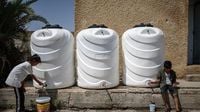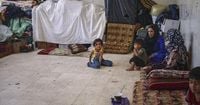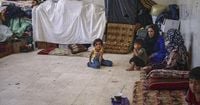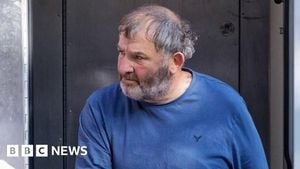In the sweltering heat of early September 2025, a school in the town of Abtaa, nestled in Syria’s southern Daraa province, has become an unlikely sanctuary for hundreds of displaced Bedouin families. The echo of children’s voices, once a sign of learning and laughter, has faded. Now, the classrooms are crowded with three or four families each, their meager possessions scattered on school desks and floors. Women and children sleep inside, while the men—seeking whatever privacy they can—bed down outside in the courtyard under the open sky.
The Bedouin families’ ordeal began in mid-July, when sectarian violence exploded in neighboring Sweida province. What started as small-scale clashes between local Sunni Muslim Bedouin clans and members of the Druze sect, the majority in Sweida, quickly escalated into a full-blown conflict. According to ABC and Arab News, the fighting soon drew in government forces siding with the Bedouins, while Druze armed groups mobilized in defense of their own. In a dramatic twist, Israel intervened with airstrikes, lending its support to the Druze side.
The violence was devastating. Hundreds of civilians—most of them Druze—were killed, and Sweida was plunged into what residents now describe as a siege. Supplies and aid trickled in, if at all. Amnesty International reported 46 cases of Druze men and women “deliberately and unlawfully killed,” in some instances by “government and government-affiliated forces in military and security uniforms.” The United Nations estimates that more than 164,000 people remain displaced as of early September, including both Druze internally displaced within Sweida and Bedouins who fled or were evacuated from the province.
For those now living in Abtaa’s school, the trauma of flight is still fresh. Munira al-Hamad, a 56-year-old from al-Kafr village in Sweida, described her family’s harrowing escape: “We remained under siege for 15 days, without bread or anything coming in,” she recalled to Arab News. It was only after the Syrian Arab Red Crescent intervened that her family managed to leave. Their ordeal was far from over—her cousin and a neighbor were attacked by armed men as they fled, their cars and belongings stolen. “We don’t want to live in tents. We want the government to find us houses or someplace fit to live,” al-Hamad pleaded. “It’s impossible for anyone to return home. Just because you’re Muslim, they’ll see you as the enemy in Sweida.”
Others shared similar stories of loss and fear. Jarrah al-Mohammad, 24, recounted how dozens of residents from his village, Sahwat Balata, trekked overnight on foot to escape the violence. “Nine people from the area were gunned down by Druze militants, including three children under the age of 15, all of them unarmed,” he said. “No one has gone back. There are houses that they burned and destroyed and stole the furniture. We can’t return to Sweida—there’s no longer security between us and the Druze … And we’re the minority in Sweida.”
In the Damascus suburb of Sayyida Zeinab, a hotel has been transformed into a shelter for displaced families. Hamoud al-Mukhmas and his wife, Munira al-Sayyad, are mourning the deaths of their two sons, aged 21 and 23. Both were shot and killed by militants, along with Hamoud’s niece and cousin, while unarmed and trying to flee their home in Shahba. “I need assistance and I need money—we don’t have a house,” al-Mukhmas told ABC. Al-Sayyad, still reeling from grief, said, “I want the government to do to these people what they did to my sons.”
Living conditions for the displaced are dire. Food aid is sporadic, and the uncertainty is crushing. The school in Abtaa is set to reopen this month, but families like al-Hamad’s have no idea where they’ll go next. Government officials insist that the displacement is temporary, but their assurances ring hollow. “There is no clarity on for how long people will be displaced, what are the mechanisms or plans or strategies that they have in order to bring them back,” said Haid Haid, a senior research fellow at the Arab Reform Initiative and Chatham House, in an interview with Arab News.
Returning the displaced to their homes appears a distant prospect. The government in Damascus and the de facto authorities in Sweida are not even holding direct talks. Sheikh Hikmat al-Hijri, a prominent Druze leader in Sweida, has called for independence for southern Syria—a demand flatly rejected by Damascus. He recently announced the formation of a “national guard” composed of several Druze armed factions, further entrenching the divide. Government officials have declined to comment on any concrete plans to address the displacement.
For many, the current crisis stirs up painful memories of Syria’s nearly 14-year civil war, when fighters and civilians opposed to President Bashar Assad were evacuated from rebel-held areas on the infamous “green buses”—a symbol of exile and defeat. The Bedouins in Sweida, who have historically worked as livestock herders, see themselves as the original inhabitants of the land, predating the Druze, who arrived in the 18th century fleeing violence in what is now Lebanon. While the two communities have largely coexisted, their history is punctuated by periodic flare-ups of violence. In 2000, a land dispute ended with a Druze man killed by a Bedouin and government forces shooting Druze protesters. After a 2018 attack by the Islamic State group on the Druze in Sweida, which killed over 200 people, the Druze accused the Bedouins of collaborating with the militants.
The seeds for the current escalation were sown in July, when a Bedouin tribe set up a checkpoint and attacked a Druze man on July 13, triggering a cycle of tit-for-tat attacks and kidnappings. Tensions had been simmering for years. One Bedouin man, displaced from al-Kafr and speaking on condition of anonymity, said his brother had been kidnapped and held for ransom in 2018 by an armed group affiliated with Sheikh al-Hijri. Just a day before the recent clashes, armed men came to his family’s home and threatened his father, forcing him to sign away the house. “The Druze are not all bad people. Some of them supported us kindly, but there are also bad militants,” he said. But he warned, “If the state does not find a solution after our homes have been occupied, we will take our rights into our own hands.”
Analysts like Haid Haid believe that while intercommunal tensions might be resolved over time, they have now become secondary to the larger political standoff between Damascus and Sweida. “Unless there is some sort of dialogue in order to overcome those differences, it’s difficult to imagine how the local disputes will be solved,” Haid noted.
For now, more than 164,000 people remain in limbo, their futures uncertain, their pasts marked by tragedy. As the school year approaches and the government offers little more than vague promises, the displaced Bedouin families of southern Syria are left to wonder if they will ever return home—or if they will be forced, yet again, to start over somewhere new.






